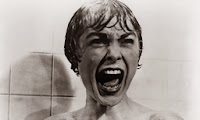Editing

- Fades from one scene to the next - creates 'blur' - uncertainty for the audience - mystery
- Cuts between his and her face quicken - building tension
- Rule of thirds placing of objects on screen
- Over 70 cuts in famous shower scene - building tension and suspense - the unknown
- Graphic match between femme fatale face from one scene and telephone of the next
- Ellipsis - miss out a chunk of time - getting to the car - leaves audience filling in the gap for themselves
- Parallel editing - what he's doing/she's doing - keeps the audience up to date with both of the main characters
Camera Movement
- High angle POV shot of police officer creates power - low angle POV shot of woman creates fragility and weakness
- High angle when femme fatale is counting money in the bathroom - makes her seem weak - emphasises that what she is doing is wrong
- Over the shoulder shot of Norman Bates choosing the key to the room - delay and build suspension over the character upon meeting him
- Low angle used when Bates talks of his mother - vulnerability
- Mid shot when Norman sits on the bed holding the newspaper containing the money just in shot - creates a sense of the audience knowing more than the character - they're one step ahead
- When he is moving the body we see him doing it but not what he's actually doing - leaves a lot up to the audiences imagination - to fill in the gaps
- Tracking shot used - creates a sense of being watched
- Long shot of walking up the stairs - walking off camera - into the unknown
Mise-en-scene (CLAMPS)
- L - Bright, artificial lighting - 'spotlight' is on femme fatale because she is in the wrong - false impression she has been caught
- L - He is in the dark and she is in the light even though she's the one who has committed the crime - audience ask questions about what he has done to make him worse
- S - Isolated location - no body would know if something were to happen - adds suspense
- L - Shadows used a lot to in force fear of the unknown
- M/C - Wigs/costume used to enforce split personality
Sound
- Non-diegetic soundtrack (asynchronous) used to build tension (stringed instruments)
- Voice over - relays what's happening off scene - asynchronous sound
- Layering of diegetic/non-diegtic - 'busy' texture to noise
- Quiet soundtrack - loud footsteps - contrast
- Repetition of same piece of music - makes audience remember the same tension from before
- Voice over - releases to audience inner thoughts (two personalities)
No comments:
Post a Comment